Alumni Spotlight: Ben Martin, M.D.
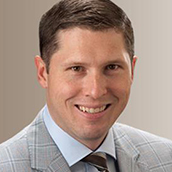 Dr. Martin graduated from UAB Urology residency in 2011. He then joined Urology of Indiana, LLC, where he practices general urology.
Dr. Martin graduated from UAB Urology residency in 2011. He then joined Urology of Indiana, LLC, where he practices general urology.
Q: What made you decide to be a urologist?
During medical school, I was attracted to urology because of the wide variety of conditions treated. I also enjoyed working on men’s health issues, and I had several great urologist mentors. I remember I looked up to their professionalism and sense of humor.
Q: What is your current practice and how did you choose to practice this area of urology?
From the beginning, I knew I wanted to enter into private practice. After graduation, I joined a large (30 physician) urology group in Indianapolis. At Urology of Indiana, I work with seven other urologists in my call group and cover three separate hospitals. Our group performs all types of urologic surgery. We also have an active robotic oncologic program. My current practice is what I call “General Urology for the 21st Century”. I personally perform all general urology cases, including my own robotic cases; specifically prostatectomy, partial nephrectomy, and full nephrectomy.
Interestingly, I was very involved with the first robotic cystectomy cases that were performed at UAB. However, I did not plan on performing robotic cystectomy cases in my practice once I graduated. But over the past four years, a urologic oncologist (Dr. Michael Large) and I have performed, on average, six to eight robotic cystectomies per month. When I graduated from UAB, I did not anticipate being involved in such a robust and busy robotic oncology practice, but UAB gave me the tools and urologic training needed to adapt in a busy, modern and successful private practice.
Q: How did you land at UAB for residency?
I am from Ohio and attended medical school at University of Cincinnati. When I was applying to residency, my mentors told me that UAB had a very well respected urology residency. So I decided to apply. I had never been to Birmingham until I showed up for my interview! I immediately fell in love with the town and UAB. The residents, physicians, and staff were all very welcoming and professional. It was clear that UAB was a great place to train and would be a good fit for me.
Q: What aspect of your time at UAB do you believe was most valuable as you started your career?
I believe I was well prepared for my career after residency. I had the technical skills and urologic knowledge to be successful. UAB has a very good operative experience for the residents. I was very comfortable operating on my own, from my first day in private practice.
However, no amount of training will fully prepare you for being on your own. My mentors at UAB (Dr. John Burns and Dr. Jim Bryant) told me to keep pushing myself and continue the learning process after residency. They were right! A lot of learning occurs in the first few years after residency. UAB prepared me to keep learning and for the challenges of a busy private practice.
Q: Did you have a particular mentor while at UAB? If so, why were they a good mentor?
Dr. Jim Bryant was a special mentor to me. He had just joined UAB from private practice, and I was his first resident on the urology service. He practiced, at that time, at UAB Highlands Hospital. Working with Dr. Bryant, I was able to learn from someone who is a true gentleman surgeon that treats his patients, staff, and colleagues with respect. Also, Dr. Bryant spent years in private practice and was very familiar with the business of medicine. He was willing to share his knowledge of practice outside the university setting with me.
Q: What is one of your fondest memories from UAB?
One of my favorite memories was working with Dr. Burns on Fridays. Dr. Burns performed all of his stone surgeries, including his PCNL cases, on Friday. Dr. Burns would routinely take the residents to Subway for a break in the middle of the day. It was a great time to unwind and recharge, before restarting the cases in the afternoon. Dr. Burns treated everyone, including the residents, as equals. As I look back at those Friday lunches today, I have come to value the advice and mentorship shared during that time.
Successful Interview Season Complete
UAB Urology interviewed 45 candidates for three slots in the incoming class of 2017. Interviews were held on Sept. 26 and Oct. 21. Thirteen of the 45 candidates participated in a visiting medical student four-week acting internship. For these 13 applicants, we piloted virtual interviews using GoToMeeting, allowing us to meet and interact with video conferencing as a follow-up to the rotation. With the rising costs of travel and applications for prospective residents, we hope to secure funding and perform further research on the use of virtual interviews for the urology match next year. Match day will be Jan. 19, 2017, and the new interns will start their general surgery PGY-1 year next June.
"We had an exciting interview season! The quality of the urology applicants is amazing! Each year, we see more and more outstanding applicants," said Peter N. Kolettis, M.D., professor and residency program director. "It is great to see so many bright students with diverse interests and diverse backgrounds interested in our field and in our program. The future of urology and our residency program is bright."
UAB Surgical Team Proud of Outcomes From ERAS Pathway
In determining clinical effectiveness, UAB Medicine relies on a thorough analysis of patient demographics, outcome and satisfaction metrics, and other information gathered across numerous disciplines.
That’s certainly true for the enhanced recovery after surgery (ERAS) pathway, which is designed to reduce post-operative complications, shorten length of stay, and hasten a patient’s return to normal functions. Outcome data suggest that ERAS is effective in improving patient experience at UAB. However, that data may be enhanced by feedback from the patients themselves, as a UAB surgical care team observed this past summer.
UAB Medicine patient Johnny Kline, diagnosed with bladder cancer in early 2016 and referred some months later to Jeffrey Nix, MD, for treatment involving a cystectomy and urinary diversion, returned to UAB in August to share his experience with his care team. The group met at the West Pavilion Conference Center for a celebration of Kline’s excellent outcomes (complete with cake and refreshments), but more significantly, the event allowed many of the 50-plus clinical and non-clinical staff members along Kline’s particular ERAS path to hear firsthand about the results of their efforts.
“UAB was too good,” Kline says. “I don’t have any problems or concerns you can learn from to improve the process, because it went too well. Dr. Nix warned me that I might be recovering in the hospital for almost two weeks; I went home on the fourth day. That new pain medication gave me no problems, just like we hoped. Through this entire surgery there was someone right there beside me asking how I was feeling or telling me what to expect, and always in plenty of detail. I was never alone, never in the dark about what was going on.”
Associate Chief Medical Officer Ben Taylor, MD, who directs UAB’s clinical effectiveness program, UAB Care, notes the value of Kline’s feedback in assessing the success of ERAS.
“The most appropriate way possible to recognize all that our teams do is having our patients here to share their experiences,” Dr. Taylor says. “It reminds us why we are all here in the first place: to take one patient, start to finish, and ensure that all procedures and elements of care line up for the best possible outcome. Input from patients guides us to do more of what works and less of what doesn’t.”
This setting also offers members of the team who engage with patients at the beginning of the ERAS pathway a chance to hear about the results of their work from a patient they might otherwise not see again. In Kline’s case, his poignant and at times emotional talk with the group reveals the morale-boosting component of sharing best-practices success stories, and in some measure reflects the “family” aspect of care that Dr. Nix emphasizes in his practice. Foremost, however, patient feedback is an additional element of cascading best practices to frontline staff.
“We anticipated that implementing ERAS pathways would have a positive impact on our patients and the care we provide at UAB,” Dr. Nix says. “Having Mr. Kline come back to share his story with our team was a tremendous opportunity to connect back to why we take process improvement so serious. This will serve as further motivation for us to continue to improve our practices going forward.”
The Appeal of ERAS
The ERAS pathway, which began at UAB in 2015 with colorectal surgery, is being applied in other disciplines and procedures throughout UAB Medicine. The results from these initial efforts demonstrated the value of ERAS, and the ERAS project for colorectal surgery received a first place UAB Health System Innovation Award for 2016, as part of a competition designed to encourage creative thinking, improve workflow, and disseminate best practices across UAB Health System entities and affiliates. That effort was led by colorectal surgeon Daniel Chu, MD, and anesthesiologist Jeffrey Simmons, MD, in close collaboration with the UAB Care team and many others.
Since implementing ERAS for colorectal surgery, the overall post-operative length of stay (LOS) was reduced to a median of 3 days, and previously observed disparities in LOS among minority patients were eliminated.
“The success of ERAS in colorectal surgery was a result of identifying, positioning, and empowering the right people to make change,” Dr. Simmons says.
The ERAS project is innovative in several ways, according to Dr. Chu.
“First, our project leveraged the infrastructure and processes of the UAB Care program to create truly multidisciplinary, team-based, and sustainable partnerships across UAB,” Dr. Chu says. “This project enlisted champions from all walks of surgical care, not only surgeons and anesthesiologists but also nurses of all specialties, HSIS programmers, residents, nutritionists, social workers, data analysts, UAB Care, etc. Many of these newly discovered relationships are now being utilized to develop other ERAS and cross-disciplinary projects such as readmission reduction programs. Second, this project was able to reduce disparities in LOS with ERAS. This finding is novel, as we show that minority patients benefit tremendously from ERAS. As a tertiary referral hospital serving a geographically wide, racially diverse population, reducing disparities is particularly relevant to our institution, and this work puts us at the forefront of recent National Institutes of Health initiatives on targeting surgical disparities. Third, our project demonstrated that change is possible. Barriers to ERAS implementation are well-documented, but with a coordinated, sustained, and multipronged approach, an entire continuum of care can be optimized to achieve potentially even better outcomes.”
Resident shares research experience
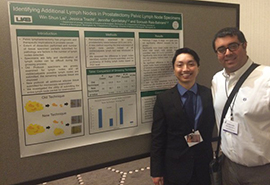 "During my UAB Urology residency, I’ve learned that performing research can be a sometimes frustrating, but also incredibly rewarding experience. I remember being dejected when my first project was not accepted for publication. I felt as if all I had to show for my hard work was criticism from reviewers. But I revised the article, incorporated the critiques, submitted to additional journals and ultimately the project was accepted. I have since presented 6 poster presentations at meetings and had 4 manuscripts accepted – including being published as first author on a paper in the Journal of Urology. This was a goal of mine since medical school, and accomplishing this goal was exciting and rewarding.
"During my UAB Urology residency, I’ve learned that performing research can be a sometimes frustrating, but also incredibly rewarding experience. I remember being dejected when my first project was not accepted for publication. I felt as if all I had to show for my hard work was criticism from reviewers. But I revised the article, incorporated the critiques, submitted to additional journals and ultimately the project was accepted. I have since presented 6 poster presentations at meetings and had 4 manuscripts accepted – including being published as first author on a paper in the Journal of Urology. This was a goal of mine since medical school, and accomplishing this goal was exciting and rewarding.
Mitchell receives K01 Award from NIH
Tanecia Mitchell, Ph.D., became the first faculty member of the UAB Department of Urology to receive a K01 award from the National Institutes of Health (NIH) to conduct her research, “Monocyte Mitochondrial Dysfunction and Kidney Stone Disease.” This is a five-year National Institute of Diabetes and Digestive and Kidney K01 Mentored Research Scientist Career Development award totaling $768,776. Her research will focus on understanding the significance of mitochondria, oxidative stress, and inflammation in monocytes using clinical samples and experimental models. Dr. Mitchell and colleagues recently published a pilot study in Urology demonstrating a potential role of monocytes in calcium oxalate kidney stone disease. She believes her investigations will provide novel insight into the role of monocytes in kidney stone formation, and may lead to strategies to intervene in the pathogenesis and prognosis of the disease.
UAB and Baptist Health partner to open new clinic in Montgomery
Urology is one of four specialties included in the new UAB Medicine Multispecialty Clinic, a partnership of Baptist Health and UAB Health System, and located at Baptist Medical Center South. The clinic opened Aug. 1 and will be located on the first and second floors of the UAB School of Medicine building (formerly the MCI building) on the campus of Baptist Medical Center South.
The urology clinic will house 3 new urologists who have been recruited by Baptist Health. All are highly trained and offer cutting-edge services and provide new surgical procedures and treatments not currently offered in the area.
- Dr. Himanshu Aggarwal is the first and only fellowship trained FPMRS/urogynecology/female urology/female incontinence specialist in river region and one of the few in whole state of Alabama.
- Dr. Geoffrey Habermacher’s practice consists of general urology with a special interest in prostate cancer, renal cancer, and laparoscopy.
- Dr. Joseph F. Pazona is the Chief of Urology at the UAB Multispecialty Clinic and Director of Robotic Surgical Services at Baptist Medical Center South. Dr. Pazona's clinical interests include: minimally invasive treatments of prostate/kidney/bladder cancer, kidney stones, male incontinence, male urinary dysfunction, and no-needle/no-scalpel vasectomy.
“We welcome these new faculty members to UAB Urology and are excited about the clinic opening in Montgomery,” said Dean G. Assimos, M.D., chair UAB Urology. “Assembling this team of highly skilled urologists with expertise in a range of areas will be a benefit to patients in the Montgomery area.”
In total, the clinic will initially offer four much-needed specialties, including urology, gastroenterology, endocrinology and rheumatology, and house a total of 10 new physicians.
“We look forward to extending the important mission of UAB Medicine to help more patients access world-class health care across Alabama,” said UAB Health System CEO Will Ferniany. “Closer proximity to care can improve health and quality of life, and this partnership will bring important specialties closer to those in and around Montgomery.”
Residents of central Alabama will no longer be forced to travel outside the area for medical services due to the overwhelming need, limited access and few similar specialists in the area. These new physicians will increase access to specialty care in a convenient, centralized location that will lead to earlier diagnosis and treatment of disease. In addition, patients will have access to clinical trials and research activities being performed at UAB that they otherwise may not have access to.
“We are excited to combine our medical experience and commitment to excellence with UAB’s highly skilled and qualified health care professionals as we work together to continue to raise the bar for top-quality medical care,” said Russell Tyner, president and CEO of Baptist Health. “I feel confident this will allow our organization to continue to meet its mission of providing the highest level of quality care to the residents of central Alabama while allowing Baptist Health to meet the growing need for health care services and expanding our services to those who matter most — our patients.”
Baptist Health has been an affiliate of the UAB Health System since 2005 and has partnered with UAB throughout the past four decades to support the UAB Internal Medicine Residency Program and, most recently, the addition of the UAB School of Medicine Montgomery Regional Campus at Baptist South. The clinic will be owned and operated by Baptist Health. UAB Health Services Foundation will employ the 10 UAB faculty physicians, several of whom will begin seeing patients in early August.
To learn more about the UAB Medicine Multispecialty Clinic and physicians, please visit www.UABMedicine-Baptist.com.
2015-2016 Update and Doximity Voting
Dear colleagues,
I hope the summer has started off well for everyone. 2015 was a good year for UAB Urology, starting with exceptional lectures from our own and visiting faculty at the Gulf Coast Urology Seminar in Sandestin, Florida. Dr. J. Patrick Selph, after finishing his fellowship in genitourinary cancer survivorship, joined the faculty in July. In October, Dr. Joseph was the first urologist in the history of the award to win the Wallace Alexander Clyde Distinguished Service Award for Excellence in Pediatrics from the Alabama Chapter of the American Academy of Pediatrics. And, last but not least, we recently matched three accomplished medical students from Baylor, Kansas, and UAB to join our program this summer. We also look forward to adding two new faculty in July -- Dr. Pankaj Dangle to our pediatric urology faculty, and Dr. Kyle Wood will be starting as an assistant professor and Urology Care Foundation grant recipient.
We are writing to ask for your help and participation in a survey of urology programs in the U.S. conducted by Doximity. U.S. News is using Doximity.com to conduct its survey of Urology programs (and other medical programs) with regards to: 1) Best Hospitals (Urology) (this is the conventional ranking they have done for many years); and, 2) Best Urology Training Programs (a new ranking performed in the late fall). Part of the Hospital rankings (number 1 above) includes a reputation score, and Doximity sends out solicited emails for your opinion on our program. If you sign up for Doximity, you may receive an invitation asking you to rate our program, and we would certainly appreciate your support.
While the survey will not come out again until winter, it is most helpful if you are already signed up for Doximity when the invitations are sent out. When the survey is sent out, you can participate in this important survey by downloading the Doximity app for your computer or phone (https://www.doximity.com) and then submitting your nomination.
Last year, UAB Urology was ranked one of the top 10 urology residency programs in the South. This recognition affirms our department’s culture and dedication to education. We are fortunate to be able to recruit outstanding residents and we are grateful for this recognition from our peer physicians in the Doximity network.
We would appreciate your consideration of signing up on Doximity.com, and, if given the opportunity, listing UAB Urology. We hope that your participation in these surveys will affirm our proud tradition of providing exceptional training in urology – past, present, and future.
Welcome New Faculty: Drs. Dangle and Wood
UAB Urology welcomes Pankaj P. Dangle, M.D., M.Ch., and Kyle D. Wood, M.D., to the department as assistant professors on July 1st, 2016.
“We are pleased both Dr. Dangle and Dr. Wood will be joining us at UAB,” said Dean Assimos, M.D., chair of UAB Department of Urology. “Dr. Dangle brings expertise in robotic assisted pediatric urology to UAB, and, to my knowledge, will be the only urologist in the state of Alabama trained to perform these robotic procedures on pediatric patients. Dr. Wood is an outstanding young urologist who recently finished his training at Wake Forest University.”
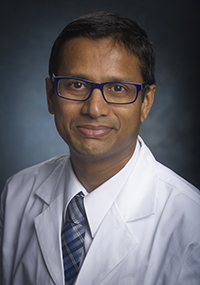 Dr. Dangle was born in India and obtained his medical degree MBBS from University of Mumbai. After completing his general surgery training, he successfully completed superspeciality training in urology with highest awards and Gold Medal from the prestigious University of Mumbai, India. He moved to United States and did his urology residency training at The University of Chicago. He recently finished a pediatric urology fellowship at The Children’s Hospital of Pittsburgh.
Dr. Dangle was born in India and obtained his medical degree MBBS from University of Mumbai. After completing his general surgery training, he successfully completed superspeciality training in urology with highest awards and Gold Medal from the prestigious University of Mumbai, India. He moved to United States and did his urology residency training at The University of Chicago. He recently finished a pediatric urology fellowship at The Children’s Hospital of Pittsburgh.
Dr. Dangle will see pediatric patients at Children’s of Alabama. His practice focuses on Complex hypospadias, disorders of sex development, vesicoureteral reflux, Myelomeningocele, Ureteropelvic junction obstruction, renal stone disease and robotic surgery.
His interest includes mentoring medical students in pursuing research during training, outcomes research, epidemiologic outcomes and testicular microvasculature with focus on endothelial progenitor cells and its role in hypoplastic testis.
 Dr. Wood completed his undergraduate degree at Brown University, graduating with honors. He then attended medical school at University of Massachusetts, and recently completed his residency at Wake Forest University.
Dr. Wood completed his undergraduate degree at Brown University, graduating with honors. He then attended medical school at University of Massachusetts, and recently completed his residency at Wake Forest University.
Dr. Wood will be significantly involved in kidney stone research. His focus will be on the metabolic pathways that lead to kidney stone disease. His surgical expertise is in kidney stones, benign prostatic hyperplasia, genitourinary reconstruction, and benign renal pathology. He is trained in open, endoscopic, laparoscopic, and robotic surgery.
Kidney Stone Group Clinic Now Accepting Referrals
UAB Medicine’s departments of urology and nephrology have collaborated to create a kidney stone clinic to reduce patients’ risk of further stone development through education and dietary and medical therapy. The group clinic, which will be conducted in the former patient resource library at The Kirklin Clinic of UAB Hospital, is one of the first such multi-disciplinary clinics in the south. Physicians are encouraged to refer patients to this clinic. Patients may also refer themselves.
Suzanne Bergman, MD, of the UAB Division of Nephrology, and Dean Assimos, MD, Chair of the Department of Urology, are to some extent modeling the clinic based on their observations at the Metabolic Stone Clinic at the University of Wisconsin Hospital.
The clinic is designed to provide an impetus for patients to get involved in their care, because most treatment regimens often call for big lifestyle changes that patients must manage themselves. Assimos notes that kidney stones impart a major economic burden on this county—several billion dollars per year—as well as having a negative impact on quality of life.
“Many patients suffer from recurrent stone events,” Assimos says. “There is high-level evidence that dietary modifications and medical therapy can limit new stone formation. The goals of this clinic will be to help select the best strategy for patients to prevent recurrent stones. It is expected that group interaction will enrich the patient’s experience.”
Bergman, too, recognizes that patients tend to feel more comfortable asking questions in a relaxed, informal group setting.
“Rather than give a patient medicine and just send them home, we will provide an opportunity for patients to share and learn in a guided setting,” Bergman says. “The studies that were done at Wisconsin suggested that patients retained information about their condition, and tended to grasp and follow treatment plans consistently, in this type of clinical setting. Bergman emphasizes that not only will every participant walk away with their own action plan, but also will benefit from participating with a group. They may also become eligible for clinical trials.
The Kidney Stone Group Session participants attend a one-time meeting of six to eight patients whose medical information and treatments will be discussed with both physicians and a nutritionist. Vital signs and blood work will be gathered so that a profile of each is available for discussion during the meeting. Participants will need to collect two 24-hour urine samples for analysis prior to the group session. The group will learn basic knowledge of conditions and treatments from an educational presentation, but nutrition and therapy regimens will be applied individually according to each patient’s history and risk factors.
“In a group ‘round table’ setting, patients can learn a lot, and maybe be inspired to make crucial lifestyle changes, when others share their experiences,” Bergman says. “We may have a patient in the group who was not drinking enough fluid, or another whose job doesn’t allow for them to go the restroom several times in a short time span. Maybe three or four in the group have low citrate. So we will discuss these topics and how they can be resolved with medication plus lifestyle changes. Patients still have the option to see both physicians individually.”
For more information about the kidney stone group sessions, physician referrals, or self referrals, please contact Lisa Harvey in Dr. Assismos’ office, 205-996-2613.
SESAUA Update 2016
Our department had a strong showing at the 80th annual Southeastern Section of the American Urological Association meeting in Nashville, Tenn., held March 17-20, 2016.
Faculty members and residents were involved in several sessions, and the department had a particularly strong showing in the areas of kidney stones and prostate cancer.
Tracey Wilson, M.D., moderated the podium session on incontinence and voiding dysfunction, and she also lent her expertise in the management of refractory overactive bladder for a panel-of-experts discussion on botulinum toxin and neuromodulation. Jeffrey Nix, M.D., moderated several oncology sessions, including a prostate cancer podium session and a kidney and adrenal cancer session.
Dean Assimos, M.D., highlighted his expertise in nephrolithiasis by moderating the debate on management of the 1.5cm renal pelvis stone. His work in the lab was also represented in multiple presentations. Thanmaya Reddy, M.D., PGY-4, presented data on oxalate concentrations in human gastrointestinal fluid, showing that in a fasted state, there is a wide range of small intestinal oxalate concentrations among individuals. This finding likely indicates inter-individual variability of the mechanisms responsible for oxalate transport and warrants further study. Ellie Killian, M.D., PGY-4, presented data on the effect of alanine on cell viability and oxalate production in primary hyperoxaluria type 1, showing that supplemental alanine in a hamster ovary model reduces the production of oxalate and improves cell viability. This finding may help guide future studies on supplemental alanine as a mechanism to reduce endogenous oxalate production in patients with type 1 primary hyperoxaluria.
Soroush Rais-Bahrami, M.D., made several presentations on prostate cancer imaging and lymph node yield. Patrick Guthrie, M.D., PGY-3, presented data showing that despite prior studies showing the African-American (AA) males have been shown to have a higher risk and grade of prostate cancer, cancer grade among a cohort of 177 AA and non-AA men at UAB undergoing MRI/US fusion-guided biopsies was equivalent. Win Shun Lai, M.D., PGY-3, presented data showing that submitting lymph node specimens taken during radical prostatectomy as an entire packet rather than individual packets yields a higher lymph node count; furthermore, the PGY status of the pathology resident affected yield--a more experienced pathology resident found more lymph nodes. The implication is submission of a single packet of lymph nodes during prostatectomy will yield higher lymph node counts and thus affect prognosis and therapy for the patient.
Members of the department also received numerous honors and awards. Dr. L. Keith Lloyd, a member of the UAB Department of Urology since 1974, was recognized at the SES meeting with a Distinguished Member Award. Dr. Lloyd’s decades of dedication and experience has been invaluable to the department.
“Dr. Lloyd is a true gentleman, and we are honored to have him as part of our department,” said Dr. Assimos. “It is not unusual for patients whom he has treated for 40 years to continue to come to see him in clinic because of the genuine, competent, and unparalleled care he provides them. We look forward to him going strong for decades ahead!”
Jubilee Tan, M.D., PGY-5, highlighted her urologic trivia knowledge by being part of the winning team during the Quiz Bowl, and she earned herself a paid trip to the AUA meeting in San Diego to represent the SES in this test of knowledge. While unfortunately the SES did not bring home the crown in San Diego, we were wowed by her trivia prowess!
Last but not least, Dr. Assimos officially began his role as president of the SESAUA for the 2016-2017 year. Among his goals are plans to increase funding for residency programs to send residents on international outreach missions, and we are all looking forward to the meeting in Austin, Texas, from March 23-26, 2017.
Outgoing and Incoming Residents 2016
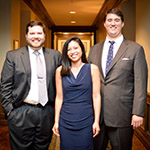 Congratulations to our resident class of 2016! We wish them all the best in their future endeavors. Dr. Daniel Benson will join a private practice in Dallas, Texas. Dr. C. Tanner Hughes will join Urology Oncology Associates in Mobile, Ala. Dr. Jubilee Tan will begin a Female Pelvic Medicine and Reconstructive Surgery Fellowship here at UAB.
Congratulations to our resident class of 2016! We wish them all the best in their future endeavors. Dr. Daniel Benson will join a private practice in Dallas, Texas. Dr. C. Tanner Hughes will join Urology Oncology Associates in Mobile, Ala. Dr. Jubilee Tan will begin a Female Pelvic Medicine and Reconstructive Surgery Fellowship here at UAB.
We also welcome our new interns: Carli Calderone, Baylor College of Medicine; Luke Ellenburg, UAB School of Medicine; Ava Saidian, University of Kansas School of Medicine.
Carli Calderone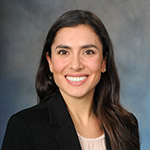
Carli Calderone was born and raised in Akron, Ohio. For her undergraduate degree she attended Miami University (of Ohio, not Florida!) where she studied Zoology, Spanish and Latin American Studies. Combining her interest in global health, science, and love of people, she decided to become a doctor. Wanting simultaneously to pursue a career in medicine and avoid another freezing Midwest winter, she decided to attend Baylor College of Medicine in Houston, Texas. There, she fell in love with the field of urology, and is lucky enough to pursue her training at UAB. In her free time, she enjoys traveling, playing and watching sports, exercise of all kinds, and most importantly, spending time with her husband and dog, Sadie.
Luke Ellenburg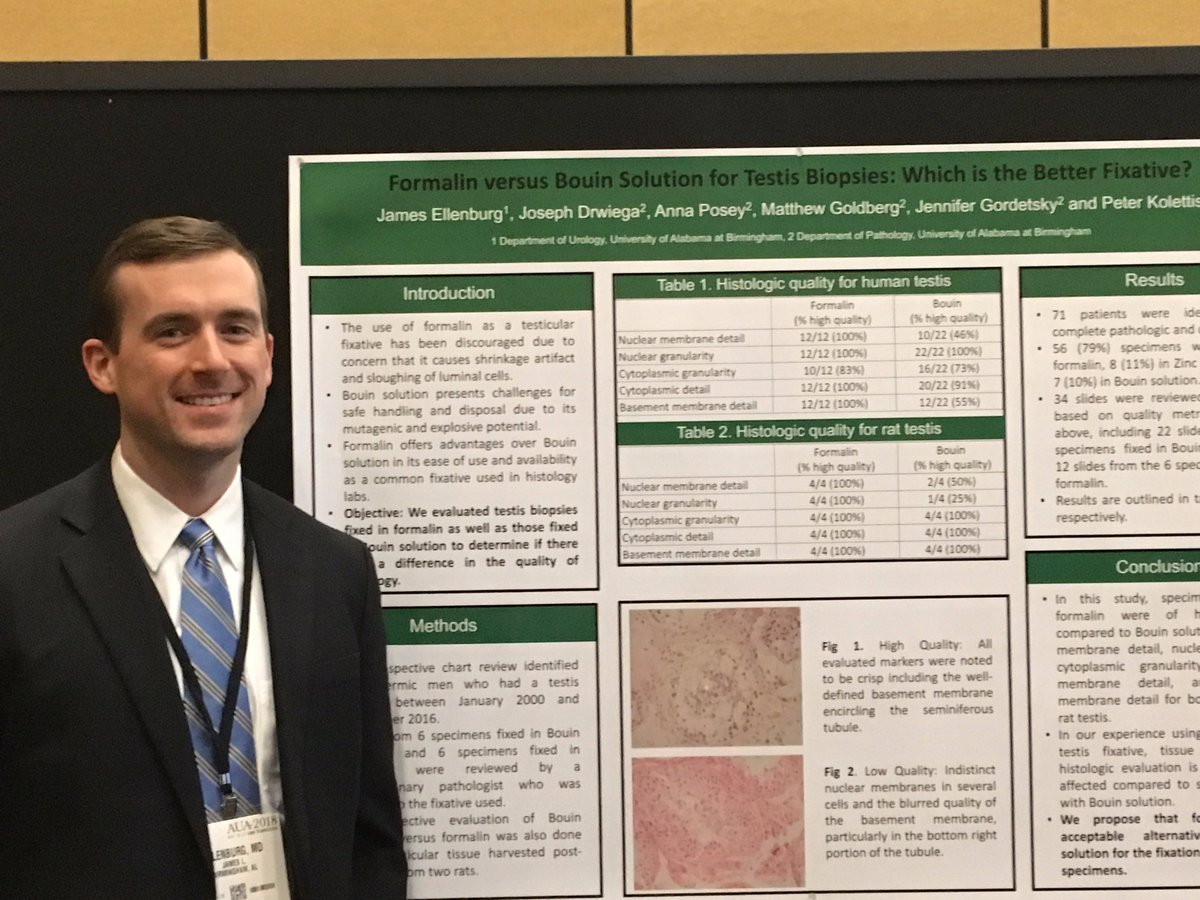
Luke Ellenburg grew up in Arab, Alabama. He graduated magna cum laude from Samford University in 2012 with a Bachelor of Science degree in Biology. He then attended the University of Alabama School of Medicine, where he was inducted into the Alpha Omega Alpha Honor Medical Society during his fourth year. An interest in surgery and the disease processes treated by urologists initially attracted Luke to the field of Urology. As a medical student, he was able to further explore this interest by working with several UAB urology residents and faculty on various research projects. At this early stage of training, his interest in subspecialties remains broad. In his free time, he enjoys running, traveling, and spending time with family and friends.
Ava Saidian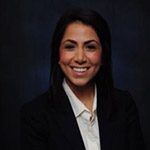
Ava Saidian is from Wichita, KS and attended the University of Texas for her undergraduate degree. After receiving a degree in Neurobiology, she went on to medical school at the University of Kansas School of Medicine. In her free time she enjoys gardening, reading non-medical books and playing tennis. Her dream is to one day own a honey bee and berry farm and sell fresh honey and fruit jam at her store "Sweet Thangs." Until then, she is very much looking forward to studying Urology at UAB and being a Urological professor and physician at an academic hospital.
Nix Named Director of Robotic Surgery
 Dr. Nix has been named the Director of Robotic Surgery for the University of Alabama Health System. He currently serves as the Director of Robotic Surgery for the Department of Urology. In this new role, he will work with faculty, staff, and administration to update and assess the process of credentialing, evaluating robotic surgery metrics (such as cost, operative time, and conversion rates), and developing a plan for the future direction of robotic surgery within the health system.
Dr. Nix has been named the Director of Robotic Surgery for the University of Alabama Health System. He currently serves as the Director of Robotic Surgery for the Department of Urology. In this new role, he will work with faculty, staff, and administration to update and assess the process of credentialing, evaluating robotic surgery metrics (such as cost, operative time, and conversion rates), and developing a plan for the future direction of robotic surgery within the health system.
Dr. Nix joined the Department of Urology in 2013 and has helped advance the use of robotic-assisted surgery within both the Department and at UAB Hospital. He was an instrumental member of the team responsible for acquisition of the new da Vinci Xi systems brought to UAB, and he has participated in strategic endeavors with Intuitive Surgical and the UAB Health System. His robotic surgery experience has evolved to include post-chemotherapy retroperitoneal lymph node dissection, off-clamp partial nephrectomy, and nephrectomy with caval thrombectomy. We look forward to the evolution and advancement of robotic-assisted surgery at UAB under the guidance of Dr. Nix.
Dr. Killian shares her training experience in Zambia
by Mary Elaine Killian, MD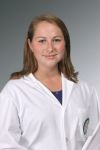
The University Teaching Hospital in Lusaka, the capital and largest city in Zambia, is a massive complex with 1,800 beds and multiple departments, but there are no pediatric urologists. From September 22 to October 2, 2015, IVUmed, a nonprofit organization committed to making quality urological care available worldwide, hosted a pediatric urology week at the hospital to help address this unmet need. I was thrilled to participate as an IVUmed Resident Scholar, sponsored by the AUA Southeastern Section.
On the first day, the pediatric nursing station served as our clinic room, and patients -- many of whom traveled long distances -- lined up around the ward to be seen. We developed an efficient triage center, with stations for basic information such as weight to be recorded, and places for examinations by the local and IVUmed urologists and anesthesiologists.
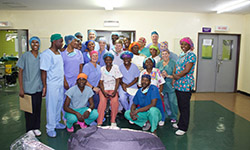 We evaluated more than 50 patients with a wide range of urologic issues, including hypospadias, trauma, epispadias, fistulae, UPJ obstruction, exstrophy, and posterior urethral valves. The need for pediatric urologists was evident with each patient we saw. Children who would have had surgery before one year of age in the United States were presenting for the first time at six years of age or older, or with indwelling catheters instead of undergoing immediate surgery. After clinic, we had the difficult task of arranging this operating schedule for the week. Since there were only enough time and resources for about 25 cases, we had to pick the cases best suited for operation that week.
We evaluated more than 50 patients with a wide range of urologic issues, including hypospadias, trauma, epispadias, fistulae, UPJ obstruction, exstrophy, and posterior urethral valves. The need for pediatric urologists was evident with each patient we saw. Children who would have had surgery before one year of age in the United States were presenting for the first time at six years of age or older, or with indwelling catheters instead of undergoing immediate surgery. After clinic, we had the difficult task of arranging this operating schedule for the week. Since there were only enough time and resources for about 25 cases, we had to pick the cases best suited for operation that week.
We performed numerous hypospadias repairs, some of which were repeat operations due to extensive scarring or wound breakdown. These are problems that we encounter in the United States but seemed to be more significant in this patient population. We also saw a three-year-old who had a ureteropelvic junction obstruction. His kidney was so dilated that it was easily palpable on physical exam and he had close to one liter of urine drain out intra-operatively once the obstruction was relieved. With the severity of his pathology, it might have been picked up on routine prenatal ultrasounds had he been in the United States. Several of the other cases performed were for patients with posterior urethral valves which were being managed with indwelling catheters, since they do not have a pediatric resectoscope with which to treat this problem. Procedures that would have been outpatient in the States were admitted to the hospital for management, largely due to the travel and financial limitations of many of the families.
 Since medical school, I have wanted to participate in an international medical mission trip. I was overjoyed to be admitted to the IVUmed Resident Scholars Program, and the experience I gained exceeded my expectations. Working with the local urologists was an incredible and educational experience. I learned much about patient care, adaptability, and resourcefulness. Our host and local urologist at UTH, Dr. Nenad Spasojevic, is one of the most energetic, creative, and innovative persons I have ever met. “No” is not a word in his vocabulary. The week was not without difficulties, but he was able to find a solution to any issue we encountered, and his work ethic was unmatched.
Since medical school, I have wanted to participate in an international medical mission trip. I was overjoyed to be admitted to the IVUmed Resident Scholars Program, and the experience I gained exceeded my expectations. Working with the local urologists was an incredible and educational experience. I learned much about patient care, adaptability, and resourcefulness. Our host and local urologist at UTH, Dr. Nenad Spasojevic, is one of the most energetic, creative, and innovative persons I have ever met. “No” is not a word in his vocabulary. The week was not without difficulties, but he was able to find a solution to any issue we encountered, and his work ethic was unmatched.
During that week, the IVUmed attending urologists Dr. Stephany and Dr. Oottamasathien worked with the local residents and staff on each case, focusing on teaching. The patience, thoroughness, and expertise they displayed was inspiring. IVUmed’s motto is “Teach One, Reach Many”, and I plan to embody that by incorporating what I learned during the mission trip into my patient care back in the U.S. Similar to UAB, University Teaching Hospital in Zambia deals with a broad a range of pathology, but without the tools and resources that I realized I take for granted in Birmingham. I consider myself very fortunate to have learned from the creativity, problem-solving skills, and perseverance of the IVUmed staff and local urologists in Zambia.
Assimos gives two talks at AUA
Department of Urology Chair Dean G. Assimos, M.D., presented a plenary session titled "AUA Guideline: Surgical Management of Ureteral Calculi" at the 2016 American Urological Association annual meeting. He also participated in a panel discussion titled "Complex Cases: Stones: 15 mm Lower Pole Stone". Both are available as webcasts online provided by the AUA.